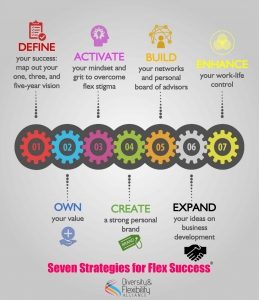Today is The Fifth Annual National Flex Day and organizations like Working Mother and One Million For Work Flexibility (1MFWF) are celebrating by sharing stories about individuals who have successfully implemented flexible work schedules and reaped countless benefits. (Tune in to their webinar on the State of National Flex from 2-3 pm ET today). Additionally, we feature a Spotlight on Flex each month which highlights a professional who is successfully working a flexible schedule.
There’s no doubt that people with flexible schedules are generally happier and more content with their careers, and they’re also often higher performing, more productive, and more engaged. From an organizational standpoint, you gain improved productivity, commitment, recruitment, retention and, in many cases, cost savings.
Bottom line: When implemented correctly, flexibility is a win-win for all.
A flexible work policy is no longer a perk, it’s now a business imperative. If your company or firm does not have a formal flexible work policy, or if you have one that’s rarely used, it’s time to reboot. The first and most important step in creating or revising your flex policy is to develop your organization’s unique business case for flexibility. This is the foundation for all aspects of your flexibility initiative –from communication to implementation, management, usage and tracking. It is also an essential element of your organization’s evolution towards a culture that truly values and embraces flexibility.
Five Factors to Consider When Creating Your Organization’s Unique Business Case for Flexibility
1. Employee Satisfaction and Tenure
Non-Stigmatized flexible work policies can increase satisfaction and tenure among all employees. Whether it’s to take care of a child or an ailing parent, to avoid tedious traffic, or to pursue a new interest, everyone needs flexibility at some point in their career. Meeting the needs of a diverse workforce will allow your organization to retain its valuable employees and thrive and prosper into the future.
2. Less Employee Turnover – Lower Attrition Expenses
Improving retention improves quality of service. The longer an employee stays and gains experience and knowledge, the higher the quality of their work. Additionally, the longer employees stay, the less your organization has to spend on recruitment and training. If available, collect your organization’s data regarding replacement hiring and training costs, as well as statistics on who is leaving and when.
3. Improved Quality of Recruits
A successful flexibility initiative helps to improve recruitment efforts and bring in the top recruits who know that your firm or company has a growing reputation as a great place to work and have a life. You are able to cherry pick the best of the best talent.
4. Client Satisfaction
If your organization is a professional services or law firm with clients, have your clients complained about high turnover? Maintaining a consistent team of professionals who know your clients’ issues and needs is essential to client relations.
5. Gender Diversity
As we mentioned, flexibility policies benefit everyone and should be de-gendered, de-parented and de-stigmatized. This, however, does not diminish from the fact that flexibility can have an impact on an organization’s ability to attract, retain and advance women. A recent study on diversity by the Boston Consulting Group found that the number one most effective factor in a woman’s career success is a formal flexible work policy. Therefore, an important part of your business case for flexibility should include its role in the gender diversity of your organization – particularly in its leadership roles.
So on this Fifth Anniversary of National Flex Day, why not take a few minutes to review your flex policy and make sure that your unique business case for flex is strong, compelling and understood throughout your organization. Your goal is to demonstrate a true connection between flexibility and your organization’s performance and bottom-line.
Once you have your unique business case for flexibility you’ll be able to develop a plan to thoughtfully implement the policy. Let us know how we can help! Our Flex Success® Framework is a five-step proprietary process for developing a successful flexible work policy and we can help guide you through the process.

 The first six strategies in our Seven Strategies for Flex Success® focus on getting your day to day flexible schedule in order to set yourself up for success in your career. It’s essential to acknowledge that this is not possible unless you can also find success and happiness outside of your career.
The first six strategies in our Seven Strategies for Flex Success® focus on getting your day to day flexible schedule in order to set yourself up for success in your career. It’s essential to acknowledge that this is not possible unless you can also find success and happiness outside of your career.